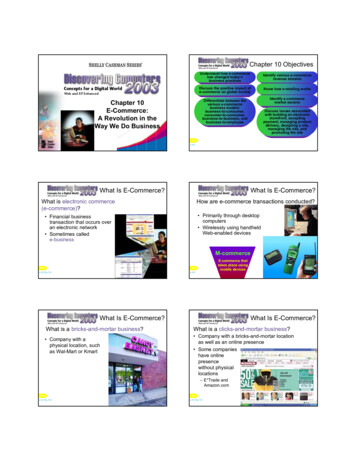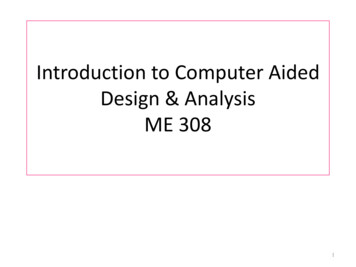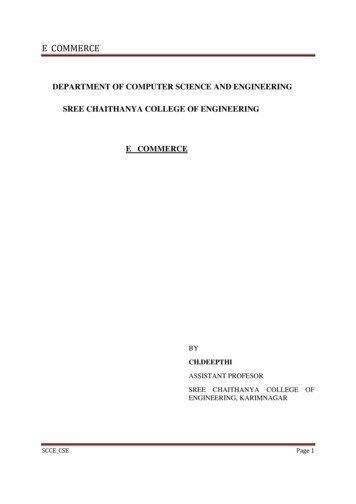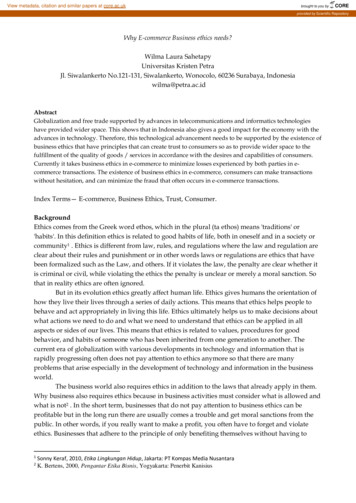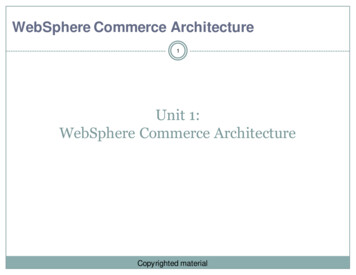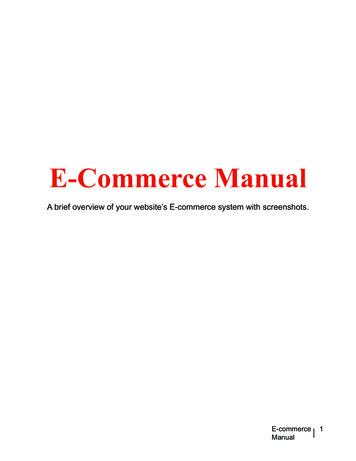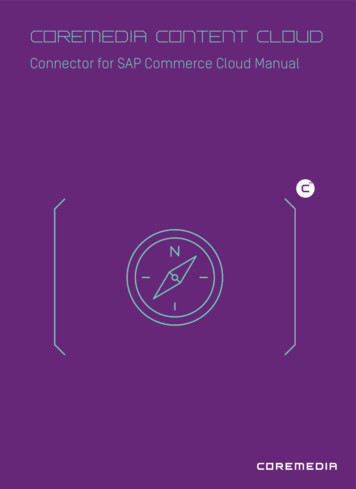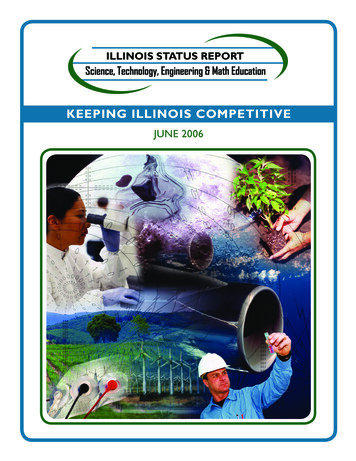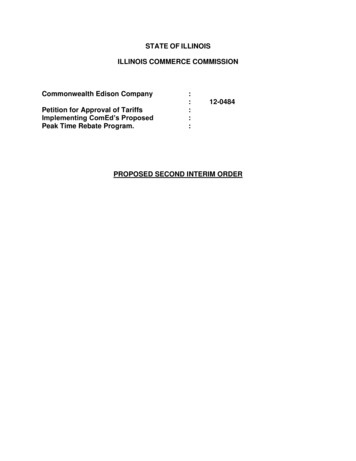
Transcription
STATE OF ILLINOISILLINOIS COMMERCE COMMISSIONCommonwealth Edison CompanyPetition for Approval of TariffsImplementing ComEd’s ProposedPeak Time Rebate Program.:::::12-0484PROPOSED SECOND INTERIM ORDER
12-0484TABLE OF CONTENTSI.INTRODUCTION . 1II.UNCONTESTED ISSUES . 4A.Background. 4B.Customer Baseline Methodology . 5C.Direct Load Control Pilot . 8D.Workshop Process and Other Outstanding Directives . 12E.Pre-Enrollment Research. 13III.COMMISSION ANALYSIS AND CONCLUSIONS . 14IV.FINDINGS AND ORDERING PARAGRAPHS . 16i
STATE OF ILLINOISILLINOIS COMMERCE COMMISSIONCommonwealth Edison CompanyPetition for Approval of TariffsImplementing ComEd’s ProposedPeak Time Rebate Program.:::::12-0484PROPOSED SECOND INTERIM ORDERI.INTRODUCTIONOn February 21, 2013, the Illinois Commerce Commission (“ICC” or“Commission”) entered its Interim Order in this proceeding (“First Interim Order”). TheFirst Interim Order reviewed Commonwealth Edison Company’s (“ComEd”) proposedRider PTR – Peak Time Rebate (“Rider PTR”), decided various contested issues withrespect to proposed Rider PTR, and approved Rider PTR as modified pursuant toSection 16-108.6(g) of the Public Utilities Act (“PUA”). The First Interim Order also: directed ComEd to file a revised Rider PTR, consistent with theconclusions in the First Interim Order; approved the proposed revisions to Rider AC - Residential Air ConditionerLoad Cycling Program, Rider POG - Parallel Operation of Retail CustomerGenerating Facilities, Rider POGNM - Parallel Operation of RetailCustomer Generating Facilities With Net Metering, and Rate RESS Retail Electric Supplier Service, and directed ComEd to file such revisedtariffs as approved; identified several unresolved issues, and directed that those issues beaddressed in the procedural manner discussed in the First Interim Order; directed the Commission’s Office of Retail Market Development (“ORMD”)to initiate a workshop process consistent with the directives in the FirstInterim Order; directed that Rider PTR be amended prior to implementation to include acustomer baseline load (“CBL”) methodology; and directed ComEd to file its proposed CBL methodology and to develop andfile a Direct Load Control (“DLC”) pilot program for customers takingservice under Rider PTR, after consultation with the Smart Grid Advisory
12-0484Council (“SGAC”), by February 1, 2014 for Commission review andapproval.First Interim Order at 32-3.On August 23, 2013, Staff of the Commission (“Staff”) filed a Staff Report onSeveral Issues Pertaining to ComEd’s Peak Time Rebate Program, as required by theCommission’s First Interim Order (“Staff Workshop Report”). On January 31, 2014,ComEd filed and served the Phase 2 direct testimony and attachments of ComEdwitnesses Robert Garcia (ComEd Exs. 7.0 - 7.01) and James C. Eber (ComEd Exs. 8.0– 8.03) presenting ComEd’s proposed CBL methodology and DLC Pilot Program,describing the results of the workshop process as set forth in the Staff WorkshopReport, and otherwise describing actions or filings by ComEd to comply with the FirstInterim Order.Pursuant to notice given in accordance with the law and the rules and regulationsof the Commission, a status hearing was convened on February 19, 2014, before a dulyauthorized Administrative Law Judge (“ALJ”). A schedule was established wherebyStaff and intervener Phase 2 direct testimony in response to ComEd's Phase 2 directtestimony was to be filed on April 8th, and ComEd Phase 2 rebuttal testimony was to befiled by April 22nd unless a different date was established at a further status hearingscheduled for April 14, 2014.The Phase 2 direct testimony of Staff witness Dr. David Brightwell (Staff Ex. 5.0)was filed and served on April 8, 2014. On April 11, 2014, ComEd filed and served thePhase 2 rebuttal testimony and attachments of ComEd witness James C. Eber (ComEdExs. 9.0 – 9.01). At the status hearing held April 14, 2014, this matter was continueduntil April 24, 2014.Pursuant to notice given in accordance with the law and the rules and regulationsof the Commission, an evidentiary hearing was convened in this docket before a dulyauthorized ALJ at the Commission’s offices in Chicago, Illinois, on April 24, 2014.Counsel for ComEd, Staff, and Comverge indicated as follows at the April 24th hearing: No contested issues remained based on the filed testimony. Comverge has no contested issues based on the proposals reflected inComEd’s and Staff’s Phase 2 testimony, has no cross examination of anywitness presented by ComEd or Staff, and supported ComEd’s proposalfor the submission of a joint draft proposed order, provided:o that the joint draft proposed order is an interim order that directsComEd to have the evaluation report of the first year results of theDLC Pilot filed with the ICC by the end of 2015 in the instantproceeding, rather than in a new proceeding, with a third and finalphase of this docket to commence at that time to consider whether2
12-0484to revise ComEd’s PTR program, marketed to customers as the“Peak Time Savings” or “PTS” program, to include DLC technology;o that the language of the joint draft proposed order reflects languagethat ComEd, Staff and Comverge accept for proposed inclusion inthe Commission’s order regarding the issue of self-selection bias inthe DLC Pilot raised in Staff’s Phase 2 direct testimony;o that Comverge be given leave to submit data requests to Staff andComEd to confirm language regarding self-selection bias thatComverge, Staff, and ComEd accept for proposed inclusion in theCommission’s order, and that Comverge also be allowed to filesuch data request responses as Comverge Cross Ex. 1 to beadmitted into evidence; ando that the joint draft proposed interim order provide that Staff andinterveners would be allowed to comment to the evaluator(s) on theevaluation report of the DLC Pilot, prior to the report being filed withthe Commission, and that testimony regarding the evaluation reportand whether or not to modify the PTS Program to include DLCtechnology for PTS participants based on the results of the DLCPilot will be presented by ComEd, as well as by Staff andinterveners, if desired, in Phase 3 of this proceeding. ComEd does not oppose Comverge’s proposals as accepted by Staff,provided that the joint draft proposed interim order includes a Supreme Ct.Rule 304(a) finding that there is no just reason to delay appeal orenforcement of both the First Interim Order and the proposed SecondInterim Order in order to start the appeal time period for any party thatplans to appeal the issues decided in the First or Second Interim Orders.ComEd states it is concerned with the possible impact on the PTSprogram if parties could potentially appeal the determinations made in theFirst Interim Order and the proposed Second Interim Order afterconclusion of the proposed Phase 3 of this Docket in 2016 or later. Staff concurs with the foregoing, provided the joint draft proposed interimorder presents the finding requested by ComEd with and without thereference to Supreme Ct. Rule 304(a). Staff questions whether SupremeCt. Rule 304(a) applies to Commission proceedings, but does not disputethe substance of the finding requested by ComEd. ComEd did not opposeStaff’s proposal to submit alternative language for the ALJ’s consideration,with any briefing on this issue to occur with the briefs on exceptions andreply briefs on exceptions.The proposal to waive briefing and proceed immediately to a proposed order wasaccepted by the ALJ. At the evidentiary hearing, the Phase 2 testimony of ComEdwitnesses Robert Garcia and James C. Eber were admitted into evidence. The Phase 23
12-0484testimony of witness David Brightwell was admitted into evidence on behalf of Staff. Noother parties presented testimony in Phase 2 of this proceeding. It was determined atthe conclusion of the evidentiary hearing that the record would be marked “heard andtaken” after the filing of Comverge’s Cross Ex. 1.0. Comverge’s Cross Ex. 1.0 was filedon May 14, 2014.As noted above, the parties to this docket agreed to submit a Joint DraftProposed Interim Order in lieu of briefing. The Joint Draft Proposed Interim Order wassubmitted on May 15, 2014. The record was marked “heard and taken” on June 3,2014.II.UNCONTESTED ISSUESA.BackgroundThe Commission’s First Interim Order approved ComEd’s Rider PTR that will bemarketed to customers as the PTS program. ComEd’s testimony explains that itsapproved PTS program is an opt-in, market-based demand response program forcustomers with Advanced Metering Infrastructure (“AMI”) meters.Residentialcustomers participating in the PTS program are provided the opportunity to earn creditson their ComEd bill when those customers are requested to temporarily reduce theirelectric load during specific periods of time identified by ComEd, known as CurtailmentPeriods. ComEd explains that those customers who reduce their electricity usage willreceive credits on their bill for the kilowatt-hours (“kWh”) of estimated electricityreduction that they achieved. ComEd notes that those customers who do not reducetheir usage during a Curtailment Period will not receive a credit, but will not be subjectto a penalty.This Second Interim Order will address 4 general issues or topics related to thePTS program that remained open at the time of the First Interim Order.First, ComEd was directed to develop and file a proposed CBL methodology afterconsultation with SGAC. ComEd explains that it will measure electricity usagereductions by comparing actual usage during a Curtailment Period to estimated usagedetermined through the use of a CBL methodology. ComEd states that it conductedstudies and consulted with SGAC and other interested stakeholders to develop aproposed CBL methodology that the Commission addresses below.Second, the First Interim Order directed ComEd to design a pilot programwherein certain PTS participants would be provided with DLC technology, such that theCommission would be able to compare PTS with and without DLC technology and makea reasoned decision on whether DLC technology should be included in the PTSprogram. In response to the Commission’s directive, ComEd consulted with SGAC andother interested stakeholders to develop a DLC Pilot proposal. ComEd explains that theproposed DLC pilot is designed to evaluate whether providing DLC technology to PTSparticipants as part of the PTS program, at no cost or at a reduced direct cost to those4
12-0484participants, will result in increased overall net benefits for all customers throughincremental demand reduction that is achieved through the use of such technology.ComEd further explains that under the DLC pilot, DLC technology will be used toautomatically control air conditioning (“AC”) equipment for customers who participate inthe PTS program and the DLC pilot. According to ComEd, while the PTS program doesnot currently include any DLC equipment, the pilot will explore the use and benefits ofDLC technology. The DLC pilot proposal is addressed below.Third, various issues that were not fully developed were directed to be addressedthrough a workshop process led by Staff. As described below, such workshops wereconducted by Staff and no contested or disputed issues remained for decision in Phase2 of this proceeding.Finally, ComEd was directed to file status reports and present a proposal forconducting pre-enrollment research. This issue is also addressed below.B.Customer Baseline MethodologyIn its First Interim Order, the Commission directed ComEd to work with SGAC todevelop a proposed CBL methodology. The Commission further directed ComEd to filethe proposed CBL methodology in the instant docket, and to file proposed tariffamendments that include the CBL methodology in Rider PTR.ComEd explains that a CBL methodology is the specific method used to estimatethe kWh of power and energy that a customer participating in a PTS program wouldhave consumed absent a request to reduce usage during a Curtailment Period basedon the customer’s unique CBL profile. ComEd notes that the customer’s unique profileis determined using factors that include a customer’s usage data for hours with similarconditions as those of the Curtailment Period.ComEd explains that it developed its proposed CBL methodology by analyzinginformation regarding CBL methodologies from other utilities that offer PTR programsand by analyzing the accuracy of various baselines. ComEd notes that it commissionedan assessment of thirteen CBL methodologies and hundreds of baseline combinationsto determine which methodology produced the most accurate estimate of customerconsumption. ComEd explains that this study randomly selected 2,000 residentialcustomers in the AMI footprint and used 2010 and 2011 hourly load data for thesummer months, June through September, to estimate this consumption. According toComEd, the estimates from each of the methodologies were compared to the actualconsumption figures in order to determine which methodologies provided the greatestaccuracy. ComEd further noted that the bias and precision for the program weredetermined based on the results of all customers and all proxy events, the spread ofbias for individual customers, and the spread of errors for individual days andcustomers. ComEd explains that in order to estimate bias, mean percentage error wasused to indicate the percentage by which measurement, on average, tends to over orunder-estimate the true demand reduction. Precision was estimated using the sum of5
12-0484the absolute difference between actual and estimated impacts over all customers andevents.Moreover, ComEd asserts that it consulted with SGAC and other stakeholdersprior to selecting the CBL methodology that ComEd submits for approval in this docket.As a result, ComEd asserts that it proposes to use the CBL methodology generallyreferred to as the heat index or “HI” method.ComEd submits the following tariff amendments to include the proposed CBLmethodology in Rider PTR:Customer Baseline Load (CBL) ProfileCBL profile means the individual residential retail customer’srepresentative hourly electricity power and energy usage, inkilowatt-hours (kWh), during a span of time that does not occurduring a specific Curtailment Period, but that corresponds to suchspecific Curtailment Period. Such residential retail customer’srepresentative electricity usage during each hour in such span oftime is determined to be equal to the average of such residentialretail customer’s kWh usage during the corresponding hour in thethree (3) individual weekdays during which such residential retailcustomer’s kWh usage for the hours corresponding to the specificCurtailment Period is at its highest within the fourteen (14) weekdayperiod immediately prior to the date of the specific CurtailmentPeriod. Notwithstanding the previous provisions of this paragraph,(a) if one or more holidays, as designated by the North AmericanElectric Reliability Corporation (NERC) and/or Curtailment Periodsfor which the residential retail customer received a notification fromthe Company as described in the Curtailment Period Notificationsection of this rider occurred during such fourteen (14) weekdayperiod, then such period is increased by the number of days duringwhich holidays and/or Curtailment Periods occurred, and (b) (i) ifthe Heat Index (HI) during such span of time in one or two of suchthree (3) individual weekdays is not within 10% of the HI during thehours of the specific Curtailment Period, then the kWh usage fromsuch day or days is not included in such average or (ii) if the HIduring such span of time in all three (3) individual weekdays is notwithin 10% of the HI during the hours of the specific CurtailmentPeriod, then the kWh usage from the single individual weekday insuch period during which such residential retail customer’s kWhusage for the hours corresponding to the specific CurtailmentPeriod is at its highest is used.Any subsequent proposal by the Company to use a differentmethodology to determine CBL profiles Such hourly electric powerand energy usage is determined in accordance with a methodology6
12-0484approved by PJM Interconnection, L.L.C. (PJM).Suchmethodology must be filed by the Company in a petition with theIllinois Commerce Commission (ICC) no later than the February 1and approved, or approved as modified, by the ICC no later thanthe April 1 prior to the beginning of the PJM Planning Year duringwhich such methodology is first used.Modification by theCommission may include but is not limited to rejecting anyproposed changes and maintaining the status quo. Any suchmethodology must be in accordance with a baseline load profilemethodology approved by PJM Interconnection, L.L.C.(PJM)However, the first such methodology must be filed by theCompany no later than February 1, 2014.Heat IndexHeat Index (HI) means a measure of weather that is a function ofair temperature and relative humidity. Generally, air temperatureand relative humidity measurements taken at the Chicago O’HareInternational Airport Weather Station are utilized in thedetermination of HIs used to determine CBL profiles. However, theCompany may utilize air temperature and relative humiditymeasurements taken at other weather stations located within itsservice territory if such measurements provide for increasedaccuracy in the determination of CBL profiles.ComEd explains that this proposed CBL methodology will be unique to eachcustomer and will be based on the individual residential customer’s hourly electricenergy usage during a period of time that does not occur during a specific CurtailmentPeriod, but that corresponds to a specifically identified Curtailment Period. According toComEd, such hourly electric energy usage is determined by identifying the fourteenprevious weekdays that are not holidays or Curtailment Event days; the HI and kWh forthe Curtailment Period days are compiled for each day and for each customer, and thedays with the three highest kWh values during the hours of the Curtailment Period areused in an average for each customer, excluding any day not within 10% of the HI forthe Curtailment Event day. If all three days are outside the 10% HI threshold, the CBLequals the kWh for the highest load day.ComEd explains that HI is commonly referred to as the Temperature HumidityIndex (“THI”) in electricity load and energy analyses in the industry, and that HI is ameasure of weather that is a function of temperature and humidity. ComEd asserts thatit will reference the O’Hare Weather Station for the temperature and relative humidityvalues used in determining the CBL, but that it may elect to utilize weather stations fromother locations within the ComEd territory for the determination of CBL if it determinesthat doing so increases the accuracy of estimating CBL and is otherwise reasonable.ComEd notes that although the HI methodology results had the second mostprecision and the second smallest bias, it was selected because the methodology with7
12-0484the most precision and the smallest bias slightly underestimates the bias toward ComEdby about 5%. In contrast, ComEd explains, the HI methodology slightly overestimatesthe bias toward the customer by about 6%. ComEd believes this will reduce the risk ofcustomer dissatisfaction during the pilot.ComEd recommends adoption of its proposed CBL Methodology, notes that Staffsupports this CBL methodology, and further notes that no other party has contested it.C.Direct Load Control PilotThe Commission’s First Interim Order directed ComEd to design a DLC pilotprogram, with input from SGAC, and to file testimony describing the design for a DLCpilot program and any other relevant information. The Commission further instructedthat implementation of the DLC pilot program should coincide with the implementation ofPTS in the summer of 2015, and directed ComEd to file a report reflecting the results ofthe first year of the pilot by the end of 2015.Additionally, in the First Interim Order, the Commission stated that the PTSprogram costs, as well as the pilot program costs and costs of providing DLC, should berecovered from all of ComEd’s residential customers, at least initially, but agreed withStaff and ComEd that this issue may be revisited during the evaluation proceeding.ComEd’s Direct Load Control Pilot for the Peak Time Savings Program is setforth in ComEd Ex. 8.01 and supported in the Phase 2 direct testimony of ComEdwitness Eber (ComEd Ex. 8.0). ComEd asserts that, beginning in June, 2013, it metwith SGAC and other stakeholders to develop objectives that would assist ComEd indetermining the potential benefits of offering DLC technology as part of the PTSprogram. ComEd asserts that it designed its DLC pilot program to examine customerbehavior, to assess whether the offer of DLC technology would have an impact oncustomer enrollment in the PTS program, and to determine the extent to which DLCtechnology would affect demand response under the PTS program.ComEd explains that it considered a number of experimental and quasiexperimental program design options for the DLC pilot, but that it ultimately proposesthe use of an event-based Randomized Control Trial (“RCT”) design and evaluation foruse in its DLC pilot. According to ComEd, under an event-based RCT design, ComEdwould enroll identical customers into groups, would randomly assign enrolled customersin each group into sub-groups, and would provide both groups with DLC technology.Then, ComEd would alternate notification and control for each sub-group across eventdays. ComEd described this testing method with an example: if 500 customers agreedto enroll in the DLC Pilot, these customers would be randomly assigned to two groupsof 250 each, sub-groups A and B. Both sub-groups would be provided with DLCtechnology. On one event day, sub-group A would have their AC unit controlled as partof the curtailment event and sub-group B would act as the control. The sub-groupacting as control would not have their AC unit automatically controlled, nor would theybe notified of the curtailment event. On a subsequent event day, sub-group B wouldparticipate in the curtailment and sub-group A would act as the control.8
12-0484ComEd explains that the event-based RCT design avoids the need to deny ordelay the treatment used in the enrollment offer (in this case, the DLC equipment), atactic which ComEd believes has a higher risk of customer dissatisfaction, and is morecost-effective.ComEd explains that its proposed DLC pilot design includes both majorresidential customer types (single-family and multi-family) as well as both types of airconditioning equipment (central air conditioning (“Central AC”) and window or plug-in airconditioning (“Plug-In AC”)). According to ComEd, this pilot design will provide data ona broad range of DLC equipment. Specifically, ComEd explains that its DLC pilot willassess the impact of load control on two distinct customer segments: single-familyhouseholds with Central AC, and multi-family householders with Plug-In AC. ComEdnotes that single-family customers represent approximately 65% of ComEd’s residentialcustomers, approximately 87% of which have Central AC, and that of the remaining35% of customers that live in multi-family dwellings, approximately 52% utilize one ormore Plug-In ACs.ComEd states that it will develop and compare enrollment data for customergroups that are solicited into the PTS program through enrollment offers made both withand without DLC technology in an effort to assess the impact of the offer of DLCtechnology on enrollment in the PTS program. Thus, ComEd proposes that the DLCpilot include three types of enabling technology that apply to customers with Central ACor customers with Plug-In AC: (1) Central AC devices; (2) ProgrammableCommunicating Thermostats (“PCTs”); and (3) Plug-In AC control devices.ComEd asserts that, under the DLC pilot, it plans to make enrollment offers tofive distinct customer groups. The single-family customers with Central AC would bedivided into three groups: (1) customers offered PTS enrollment with no enablingtechnology (Group 1); (2) customers offered PTS with a free DLC device for Central AC(Group 2); and (3) customers offered PTS with a customer purchased PCT funded by apartially offsetting bill credit (Group 3). Multi-family customers with Plug-In AC units willbe divided into two groups: (1) customers offered PTS enrollment with no enablingtechnology (Group 4); and (2) customers offered PTS with a free DLC device to beinstalled by the customer for controlling a plug-in AC unit (Group 5).Under ComEd’s original proposed DLC pilot, ComEd proposed that enrollmentbe targeted at 500 customers in each customer group, which would then be divided intotwo randomly selected sub-groups of 250 participants each, designed as “sub-group A”and “sub-group B”. Following discussion and agreement with Staff, ComEd revised itsproposal. Under ComEd’s revised proposal, supported by Staff, ComEd plans to overenroll participants in Group 2, the group that would receive a DLC device for CentralAC. ComEd would then divide Group 2 to form sub-groups A, B, and C. ComEdasserts that it will enroll randomly assigned volunteers in Subgroup C who expressedtheir willingness to receive an AC Switch; however, these participants will not receiveDLC technology. ComEd explains that under this revised proposal, all other groups will9
12-0484enroll 500 participants and will be divided into sub-groups A and B, which will participatein different Curtailment Periods; Group 2, however, will enroll 750 participants and willbe divided into sub-groups A, B, and C. While sub-groups A and B will participate indifferent Curtailment Periods, sub-group C will receive event notifications for all events.ComEd submits a summary of its proposed tariff amendments to reflect theproposed DLC pilot program, as well as the Commission’s determinations regardingcost recovery and allocation: Prerequisites of Service section (Sheet No. 352): Tariff revisions areincluded to provide prerequisites for customers participating in the DLCpilot. These revisions explain that a residential customer who participatesin the DLC pilot program is required to have the appropriate equipmentinstalled before participating in the pilot. The appropriate equipmentincludes a DLC device or PCT for single family households with central airconditioning units and plug-in DLC devices for multi family households forroom air conditioning unit(s).These prerequisites also includerequirements that the DLC equipment have remote control capability andrequire ComEd to work with customers to ensure proper installation oftheir DLC devices. Peak Time Rebate (Sheet No. 353) and Curtailment Period Notificationsections (Sheet No. 354): Tariff revisions are included to explain that acredit for a curtailment event is only provided to those customers for whomComEd issues curtailment notifications for that event. These revisionsallow sub-groups of DLC participants to have different curtailment events,as described in Mr. Eber’s Phase 2 direct testimony. All PTS customersnot participating in the DLC pilot will continue to be called upon to curtail atthe same time (i.e., for the same events). Direct Load Control Pilot Program section (Sheet Nos. 354 and 354.1):These tariff revisions are included to explain: (1) that the program isoffered to randomly selected residential customers who acceptedComEd’s offer to participate in the PTS program with specific technology;(2) the varying types of equipment used in different segments of the pilotand whether such equipment is installed by ComEd at no cost orpurchased and installed by customers with a bill credit for 100 offsettinga portion of the costs; (3) that the remote control capabilities of thedevices can be overridden by customers during a curtailment period; and(4) that when ComEd issues a curtailment period notification to a DLCpilot participant, ComEd may electronically communicate with the deviceto either cycle the AC unit or to turn up the temperature on the PCTwithout any further customer notification. Mr. Eber further explains why, inlight of all the other functionalities of these devices and their availability inthe market, ComEd proposes to offer a 100 credit and not the full cost ofa PCT for purposes of this pilot.10
12-0484 Termination of Service section (Sheet No. 354.1): These tariff revisionsare included to explain that ComEd will remove the DLC device, if acustomer requests its removal after such customer terminates itsparticipation in the DLC pilot. Miscellaneous section (Sheet No. 355): Tariff revisions are included todescribe ComEd’s DLC pilot program reporting requirement, and to furtherexplain that all prudent and reasonable costs related to theimplementation of Rider PTR – including the implementation of the DLCpilot – are recovered from all residential customers through Rate DSPP –Delivery Service Pricing and Performance (“Rate DSPP”), as directed bythe Commission. First Interim Order at 22-23 and 31. But, as previouslynoted, these rate design decisions regarding recovery during the four-yearevaluation period of PTR may be revisited in the PTS evaluationproceeding.ComEd explains that, following the summer of 2015, an analysis of the results ofthe DLC pilot would be conducted and an evaluation report
Several Issues Pertaining to ComEd's Peak Time Rebate Program, as required by the Commission's First Interim Order ("Staff Workshop Report"). On January 31, 2014, ComEd filed and served the Phase 2 direct testimony and attachments of ComEd witnesses Robert Garcia (ComEd Exs. 7.0 - 7.01) and James C. Eber (ComEd Exs. 8.0


